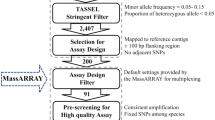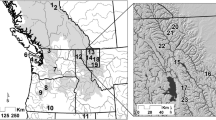Abstract
Polyploid organisms pose substantial obstacles to genetic analysis, as molecular assay data are usually difficult to evaluate in a Mendelian framework. Green sturgeon (Acipenser medirostris) is a tetraploid species and is facing significant conservation challenges, including bycatch in ocean fisheries. We present here novel molecular genetic assays and analytical methodology for green sturgeon that allow discrimination of fish from the two visually indistinguishable distinct population segments (DPSs), and also provide individual-specific genetic tags. We show how the relative fluorescence intensity data from a standard quantitative PCR assay, designed for a biallelic single nucleotide polymorphism, can be grouped into “genotype categories” using standard analytical software and post-processing manipulation. We then show how these genotype category data can be used to discriminate green sturgeon from the southern DPS, which is protected under the US Endangered Species Act, and the northern DPS, which is not. We also show how these data can be used to reliably identify individual green sturgeon, and can therefore be used in capture/recapture analyses. Both types of identification are extremely accurate even when fewer than half of the assays are successfully called. We then apply these new techniques to show that proportions of the two green sturgeon DPSs are extremely different in the two major fishery areas where they are encountered as bycatch. While these assays and methods do not provide data that can be used in pedigree-based analyses, they are an important advance in the application of genetic analysis to conservation and management of polyploid organisms.







Similar content being viewed by others
References
Adams PB, Grimes C, Hightower JE, Lindley ST, Moser ML, Parsley MJ (2007) Population status of North American green sturgeon, Acipenser medirostris. Environ Biol Fishes 79:339–356
Anderson EC, Waples RS, Kalinowski ST (2008) An improved method for predicting the accuracy of genetic stock identification. Can J Fish Aquat Sci 65:1475–1486
Andreakis N, Kooistra WHCF, Procaccini G (2009) High genetic diversity and connectivity in the polyploid invasive seaweed Asparagopsis taxiformis ( Bonnemaisoniales) in the Mediterranean, explored with microsatellite alleles and multilocus genotypes. Mol Ecol 18:212–226
Catchen JM, Amores A, Hohenlohe P, Cresko W, Postlethwait JH (2011) Stacks: building and genoty** loci de novo from short-read sequences. G3: Genes, Genomes, Genet 1:171–182
Dempster AP, Laird NM, Rubin DB (1977) Maximum likelihood from incomplete data via the EM algorithm (with discussion). J R Stat Soc Series B 39:1–38
Havelka M, Kaspar V, Hulák M, Flajshans M (2011) Sturgeon genetics and cytogenetics: a review related to ploidy levels and interspecific hybridization. Folia Zoologica 60:93–103
Israel JA, Bando KJ, Anderson EC, May B (2009) Polyploid microsatellite data reveal stock complexity among estuarine North American green sturgeon ( Acipenser medirostris). Can J Fish Aquat Sci 66:1491–1504
Ludwig A, Belfiore NM, Pitra C, Svirsky V, Jenneckens I (2001) Genome duplication events and functional reduction of ploidy levels in sturgeon (Acipenser, Huso and Scaphirhynchus). Genetics 158:1203–1215
Mable BK (2004) ‘Why polyploidy is rarer in animals than in plants’: myths and mechanisms. Biol J Linn Soc 82:453–466
NMFS (2015) Southern distinct population segment of the North American green sturgeon (Acipenser medirostris) 5-year review: summary and evaluation. Tech. rep., National Marine Fisheries Service, West Coast Region, Long Beach, CA, https://swfsc.noaa.gov/publications/FED/00630.pdf
Peterson BK, Weber JN, Kay EH, Fisher HS, Hoekstra HE (2012) Double digest RADseq: an inexpensive method for de novo SNP discovery and genoty** in model and non-model species. PLoS ONE 7(e37):135
R Core Team (2015) R: a language and environment for statistical computing. R Foundation for Statistical Computing, Vienna, Austria, http://www.R-project.org/
Rosenberg NA (2004) DISTRUCT: a program for the graphical display of population structure. Mol Ecol Notes 4:137–138
Schreier A, Langness OP, Israel JA, Van Dyke E (2016) Further investigation of green sturgeon (Acipenser medirostris) distinct population segment composition in non-natal estuaries and preliminary evidence of Columbia River spawning. Environ Biol Fishes 99(12):1021–1032
Schreier AD, Mahardja B, May B (2013) Patterns of population structure vary across the range of the white sturgeon. Trans Am Fish Soc 142:1273–1286
Voorrips RE, Gort G, Vosman B (2011) Genotype calling in tetraploid species from bi-allelic marker data using mixture models. BMC Bioinform 12:172
Waples RS, Anderson EC (2017) Purging putative siblings from population genetic data sets: a cautionary view. Mol Ecol 26(5):1211–1224
Acknowledgements
We are grateful to Phaedra Doukakis, Melissa Neuman, and Susan Wang (NMFS West Coast Regional Office) for engaging us in this project with the goal of identifying green sturgeon bycatch, Toz Soto (Karuk Tribe) and Bill Poytress (US Fish and Wildlife Service) for providing samples of juvenile green sturgeon from the Klamath and Sacramento rivers, respectively, Vanessa Apkenas and Cassie Columbus (Southwest Fisheries Science Center) for assistance with laboratory analyses. Joshua Strange (Stillwater Sciences) and Stephen Kullman (Wiyot Tribe) provided samples from fish encountered in the Eel River, and observations regarding their reproductive status, and staff from the NMFS West Coast Fisheries Observer Program provided samples from fishery bycatch. Steven Lindley, Ethan Mora, and two anonymous referees provided helpful comments on the manuscript.
Author information
Authors and Affiliations
Corresponding author
Electronic supplementary material
Below is the link to the electronic supplementary material.
Rights and permissions
About this article
Cite this article
Anderson, E.C., Ng, T.C., Crandall, E.D. et al. Genetic and individual assignment of tetraploid green sturgeon with SNP assay data. Conserv Genet 18, 1119–1130 (2017). https://doi.org/10.1007/s10592-017-0963-5
Received:
Accepted:
Published:
Issue Date:
DOI: https://doi.org/10.1007/s10592-017-0963-5




